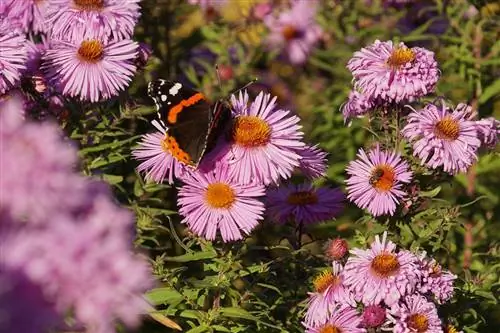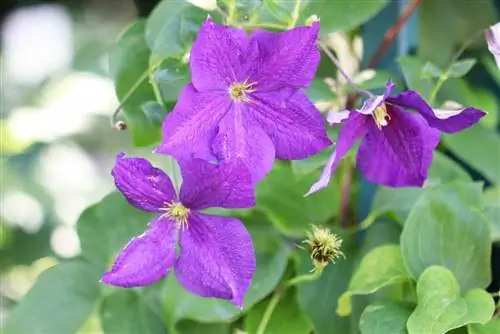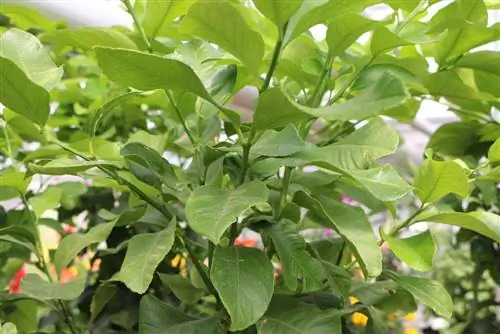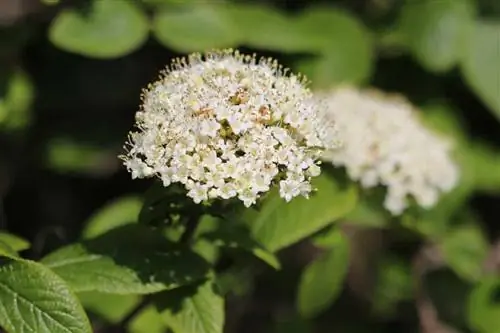- Author admin [email protected].
- Public 2023-12-17 03:39.
- Last modified 2025-01-24 12:45.
The lantana is a popular flowering plant in many gardens that can be kept for several years if overwintered properly. The home of the pretty plant with wonderfully fragrant flowers is in North and Central America. Due to its ability to change the colors of its flowers within its color palette, the flowering plant is called lantana. It can be grown as a bush or as a standard tree. In addition, the plant with its colorful flowers is extremely easy to care for and is ideal for keeping in a pot and overwintering.
Caution poisonous
Always wear gloves when handling lantana. Because all parts of the plant are poisonous, especially the fruits. For this reason alone, it is important to clean out the withered flowers. Lantana contains lantadenes A and B, icterogenin and triterpenes. Contact with the leaves can cause skin irritation in some people.
Location and soil
Since the lantana originally comes from a sunny region, it naturally also likes a sunny location that also protects it from rain. However, a location in partial shade that is bright is still acceptable. The location should not be darker, otherwise the Lantana camara will lose its leaves and the flowering will diminish or even stop altogether. The optimal soil for lantana consists of nutrient-rich, lime-free and loose substrate that is neutral or slightly acidic. A mixture of fresh garden soil and mature compost is ideal and a little gravel or coconut fiber is added to loosen it up. This allows the water to drain easily.
Tip:
If the garden soil is too firm and does not allow water to pass through, it is advisable to install drainage in the lower area of the planting hole. For example, collected stones, gravel, coarse sand or shards or a mixture of everything are suitable.
Bucket Culture
The lantanas are usually kept in buckets because, among other things, this makes overwintering easier. If you want to keep the plant in a pot from the start, you should make sure there is good drainage made of broken clay, gravel or small stones you have collected yourself on the bottom of the container. It is equally important to place a clay shard on the drainage hole in the ground so that it does not become clogged with plant substrate.
Repotting
- as soon as roots grow out of the drainage hole at the bottom of the container
- Vessel should be one size larger than previous vessel
- Roots should not be injured if possible
- Don’t forget drainage!
Watering and fertilizing
The lantana likes regular, not excessive watering, although the potting soil should always be kept evenly moist. The plant prefers to be watered with rainwater or other lime-free water. The correct time to water is as soon as the top soil in the pot feels dry and there is no more substrate left hanging on your thumb (thumb test).
Tip:
Since the Lantana camara does not tolerate waterlogging, excess water should always be poured out into the planter or saucer.
- first time after leaf formation is complete in spring
- Rock dust can be used as a long-term fertilizer
- during the flowering period every two weeks
- From September fertilizer should be applied at larger intervals
- organic fertilizer, for example plant manure or mature compost
- commercial flowering plant fertilizer also suitable
- Always pay attention to the information on the fertilizer packaging
Propagate
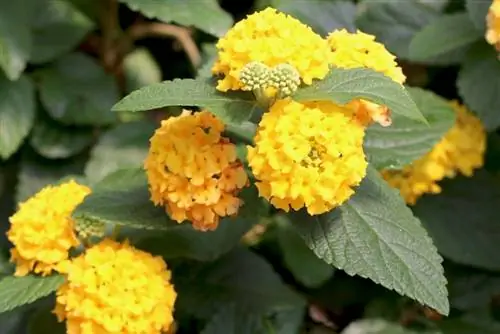
Radiantes can be propagated from seeds and cuttings, although propagation from cuttings is more common.
Seeds
If you want to grow lantana from seeds, it is easy for you to get the seeds from your own plants. If you don't yet have lantana, you can purchase the appropriate seeds commercially. In order to obtain your own seeds, you must of course allow the spent inflorescence to mature properly into a fruiting body. The small, black berries contain the seeds.
Tip:
Always wear gloves when removing the pulp, as the plant and especially its fruits are poisonous.
Sowing is best done in late winter or early spring, although it can be done all year round. To do this, put some potting soil in small containers. These don't always have to be flower pots or seed boxes, you can also use rinsed yogurt cups. Place the seeds on the soil and cover them lightly with some growing substrate. Place the pots in a sunny, warm location. Keep the soil evenly moist, but not too wet, and cover the containers with a transparent film or a thin sheet of glass. But don't forget to ventilate regularly so that the seeds don't get moldy. The seedlings will appear after about two to four weeks. As soon as the small plants have three leaves, they are pricked out and later planted into larger pots or containers when they are at least eight to ten centimeters high. With this propagation method, it takes many years before the lantana shows flowers.
Cuttings
It is very practical to propagate from cuttings after the annual cut, as there is then enough plant material and there is no need to take extra from the flowering plant. To do this, cut head cuttings that are approximately 13 to 15 centimeters in size and remove all but the top three leaves. Then put the cuttings in pots with potting soil. Always keep the growing substrate moist and place a film over the cuttings and ventilate them regularly. As soon as new leaves sprout, the cuttings have rooted successfully. Then they can be transplanted into larger pots. Alternatively, you can place the cuttings in a small glass of water and wait about one to three weeks. They should then be rooted and can be planted in pots.
Cutting
The lantana is cut at the beginning of the shoots and shortened very much. To do this, either cut the shoots in half or shorten the entire plant to a hand's width. This way it can thrive again and produce countless flowers that attract bees, butterflies and other insects.
Cleaning out the flowers: In order to extend the flowering season of the Lantana camara, the withered flowers should be cleaned out regularly throughout the entire flowering period. This means that the beautiful plant blooms well into autumn.
Wintering
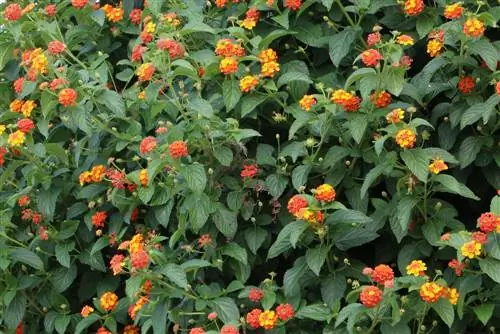
Since the plants cannot tolerate frost, they must be overwintered in a bright room at temperatures of around seven to 15 degrees. Overwintering in dark rooms is also possible. Then the temperature should be between five and ten degrees. In the dark, the lantana loses its leaves and goes into a dormant period until spring. At the end of February, the plants can be placed bright and warm again. However, they are only allowed outside after the last night frosts. Plants that have already started budding should first be accustomed to the sun and should therefore be kept in shade to partial shade for some time.
Diseases and pests
In winter quarters, lantanas are susceptible to spider mites and whiteflies. Sometimes aphids can also be found on the plants, which were probably too small to be noticed during the pest inspection before they were put into winter quarters. For example, you can use a parasitic wasp called Encarsia formosa to combat whiteflies. Lady beetle larvae of the species Adalia bipunctata can help you with an aphid infestation and predatory mites are of good use in an infestation with spider mites. The beneficial insects can be purchased in garden centers.
Popular varieties (flower color)
White:
Lantana camara ‘Avalanche’
White-Yellow:
Lantana camara 'Snow White'
Pink-Purple-Yellow:
Lantana camara ‘Cochinelle’
Pink-Red
Lantana camara ‘Pink Bird’
Red-Pink-White:
Lantana camara 'Ortenburg Castle'
Red:
- Lantana camara ‘Grenat Corse’
- Lantana camara ‘Rouge Corde’
Purple-White:
Lantana camara ‘Hortemburg’
Violet:
Lantana camara ‘Feston Rose’
Orange:
- Lantana camara ‘Orange Pur’
- Lantana camara ‘Brasier’
- Lantana camara ‘Confetti’
- Lantana camara ‘Orange Lampant’
- Lantana camara 'Prof. Raoux'
- Lantana camara ‘Radiation’
Yellow:
- Lantana camara ‘Mine d’Or’
- Lantana camara 'Variegata' with variegated foliage
Conclusion
Even though lantana is poisonous and has to be overwintered, it is still a popular, easy-care plant for hobby gardeners. Many a lover of this plant has fallen into a passion for collecting because of the various varieties with bright colors and always buys a new lantana for their pot and container garden.


